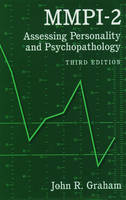
MMPI-2
Oxford University Press Inc (Verlag)
978-0-19-511481-2 (ISBN)
- Titel ist leider vergriffen;
keine Neuauflage - Artikel merken
MMPI-2: Assessing Personality and Psychopathology, 3/E is an updated version of a book that has been used extensively in graduate courses in psychological assessment and by others who are interested in learning about the MMPI-2, conducting research concerning the MMPI-2, or using the MMPI-1 clinically. The development of the original MMPI is described, as is the revision of the MMPI that resulted in two instruments - the MMPI-1 for use with adults and MMPI-A for use with adolescents. Detailed instructions for administering, scoring, and coding the MMPI-2 are presented. Interpretation of validity, clinical, content, and supplementary scales is discussed and illustrated with cases. There is a section concerning the use of the MMPI-2 with special populations such as older adults, ethnic minorities, medical patients, and prisoners. The chapter on supplementary scales includes information about several new scales that were developed after the MMPI-2 was published. Two new validity scales, Superlative (S) and Infrequency-Psychopathology F(p), and two relatively new addiction scales, Addiction Acknowledgement (AAS) and Addiction Potential (APS) are presented.
The Hostility (Ho) scale, which has been very successful in predicting negative health events, such as coronary artery disease, is described in some detail. A new chatper has been added related to computerized administration, scoring, and interpretation of the MMPI-2. The adolescent form of the test (MMPI-2) is described and its interpretation is illustrated. Appendices present technical information about the numerous MMPI-2 scales.
1. Development of the MMPI and the MMPI-2; Development of the MMPI; Development of the MMPI-2; 2. Administration and Scoring; Qualifications of Test Users; Who Can Take the MMPI-2?; Administering the MMPI-2; Testing Materials; Scoring the MMPI-2; Constructing hte Profile; Coding the Profile; 3. The Validity Scales; Cannot Say (?) Score; L (L) Scale; Infrequency (F) Scale; Correction (K) Scale; Back Infrequency (Fb) Scale; Variable Response Inconsistency (VRIN) Scale; True Response Inconsistency (TRIN) Scale; Inrequency-Psychopathology [F(p)] Scale; Superlative (S) Scale; Other Validity Indicators; Profile Invalidity; Deviant Response Sets and Styles; Random Responding; All True Responding; All False Responding; Negative Self-Presentation; Positive Self-Presentation; 4. The Clinical Scales; Scale 1 (Hypochondriasis); Scale 2 (Depression); Scale 3 (Hysteria); Scale 4 (Psychopathic Deviate); Scale 5 (Masculinity-Femininity); Scale 6 (Paranoia); Scale 7 (Psychasthenia); Scale 8 (Schizophrenia); Scale 9 (Hypomania); Scale 0 (Social Introversion); 5. Profile Configurations; Determining Code Types; Two-Point Code Types; Three-Point Code Types; Other Configural Aspects; 6. Content Interpretation; The Harris-Lingoes Subscales; Subscales for Scales 5 and 0; The MMPI-2 Content Scales; Content Component Scales; Critical Items; 7. Supplementary Scales; Anxiety (A) and Repression (R) Scales; Ego Strength (Es) Scale; MacAndrew Alcoholism Scale-Revised (MAC-R); Addiction Acknowledgment Scale (AAS); Addition Potential Scale (APS); Martial Distress Scale (MDS); Hostility (Ho) Scale; Overcontroled-Hostility (O-H) Scale; Dominance (Do) Scale; Social Responsibility (Re) Scale; College Maladjustment (Mt) Scale; Masculine Gender Role (GM) and Feminine Gender Role (GF) Scales; Post-traumatic Stress Disorder (PK) Scale; Subtle-Obvious Subscales; 8. Psychometric Considerations; Standardization; Scale Construction; Norms; T-score Transformations; Temporal Stability; Internal Consistency; Scale-Level Facotr Structure; Item-Level Factor Structure; Response Sets and Styles; Validity; Validity of the Original MMPI; Comparability of MMPI and MMPI-2 Raw Scores; Comparability of MMPI and MMPI-2 T Scores; Comparability of MMPI and MMPI-2 Configurations; Validity of the MMPI-2; 9. Use with Special Groups; Adolescents; Older Adults; Ethnic Minorities; African Americans; Hispanics; Native Americans; Asian Americans; Medical Patients; Correctional Settings; Nonclinical Settings; 10. An Interpretive Strategy; A General Strategy; Test-takking Attitude; Adjustment Level; Characterisitc Traits and Behaviors; Dynamics and Etiology; Diagnostic Impressions; Treatment Implications; Specific Referral Questions; An Illustrative Case; Additional Practice Cases; Giving Feedback to Clients; 11. Computerized Administration, Scoring, and Interpretatation; Automated Administration; Automated Scoring; Automated Interpretation; Sample of Computerized Interpreted Report; Comparison of Computerized and Clinician-Generated Interpretations; Evaluation of Automated Services; Professional Guidelines for Computerized Assessment; Evaluating the Validity of Computerized Interpretations; Conclusions and Recommendations; Chapter Appendix; 12. Assessing Adolescents: The MMPI-A; Development of the MMPI-A; MMPI-A Validity Scales; MMPI-A Supplementary Scales; MMPI-A Harris-Lingoes Subscales; MMPI-A Scale 0 Subscales; MMPI-A Content Scales; MMPI-A Harris-Lingoes Subscales; MMPI-A Scale 0 Subscales; Reliability and Validity of the MMPI-A; Interpreting the MMPI-A Validity Scales; Interpreting the MMPI-A Clinical Scales; Interpreting the MMPI-A Content Scales; MMPI-A Critical Items; MMPI-A Interpretive Strategy; Illustrative Case; 13. Forensic Applications of the MMPI-2; Admissibility of MMPI-2 Evidence; Some Important Issues; Norms; Correlates of Scales; Use with Ethnic Minorities; Profiling; Administering the MMPI-2; Scoring the MMPI-2; Interpreting the MMPI-2; Some Forensic Uses; Detecting Invalid Responding; Assessing Clinical Conditions; Screening for Substance Abuse; Predicting Dangerousness; Assessing Insanity; Assessing Competency to Stand Trial; Domestic Relations Evaluations; Correctional Settings; Personal Injury Assessments; Presenting Expert Opinions Based on the MMPI-2; REFERENCES; APPENDIXES; A. Composition of Standard Validity and Clinical Scales; B. T-Score Conversions for Standard Validity and Clinical Scales; C. Composition of Harris-Lingoes Subscales; D. Linear T-score Conversions for Harris-Lingoes Subscales; E. Composition of Si Subscales; F. Linear T-score Conversions for Si Subscales; G. Composition of Content Scales; H. Uniform T-score Convesions for Content Scales; I. Critical Item Lists; J. Composition of Supplementary Scales; K. Linear T-score Conversions for Supplementary Scales; L. Intercorrelations of MMPI-2 Scales for Normative Sample; M. Percentile Equivalents for Uniform T-scores; N. Data for Four Practice Cases
| Erscheint lt. Verlag | 4.11.1999 |
|---|---|
| Zusatzinfo | tables |
| Verlagsort | New York |
| Sprache | englisch |
| Themenwelt | Geisteswissenschaften ► Psychologie ► Psychoanalyse / Tiefenpsychologie |
| Geisteswissenschaften ► Psychologie ► Test in der Psychologie | |
| ISBN-10 | 0-19-511481-7 / 0195114817 |
| ISBN-13 | 978-0-19-511481-2 / 9780195114812 |
| Zustand | Neuware |
| Haben Sie eine Frage zum Produkt? |
aus dem Bereich


